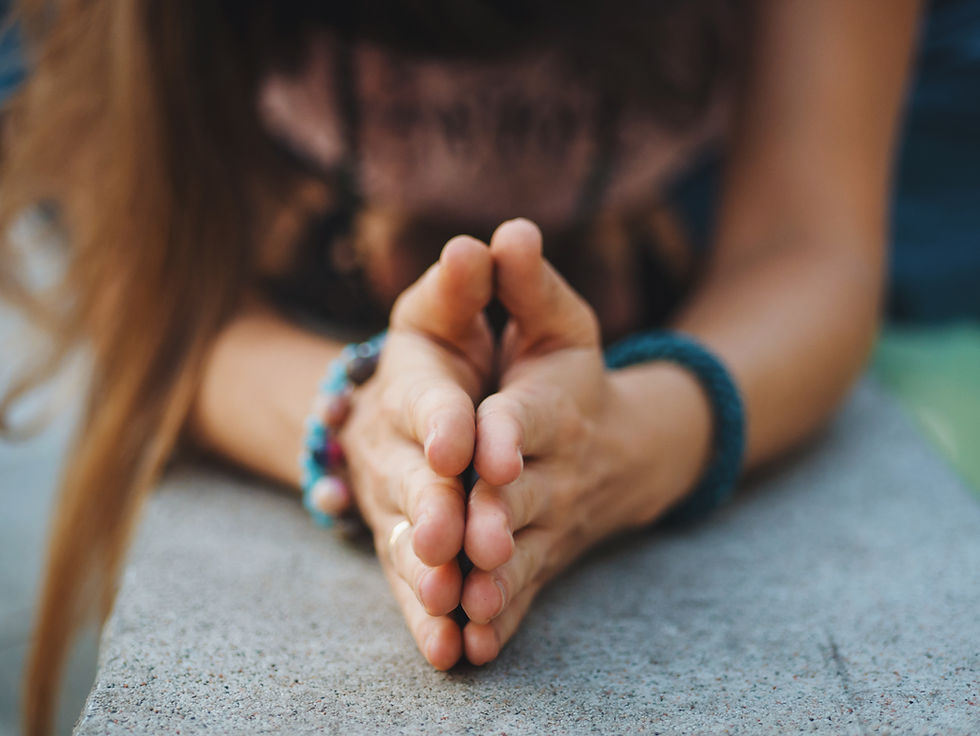Yoga Philosophy Basics for Beginners: 4 Systems to Know
- Joy Zazzera

- Jul 20
- 4 min read
Updated: Aug 6
Understanding the Bigger Picture of Yoga
Yoga isn’t just about movement—it’s a rich and ancient system for understanding how we live, think, and grow. Long before yoga was associated with stretchy pants and studio classes, it was and remains a philosophy—a holistic way of approaching the body, the breath, the mind, and even the soul.
If you’ve ever wondered about the deeper meaning behind practicing yoga, this article - Yoga Philosophy Basics for Beginners - offers a simple introduction to four foundational systems: the 8 Limbs of Yoga, the 5 Koshas, the 5 Kleshas, and the 7 Chakras. These concepts aren't meant to be intimidating—they're guideposts. Think of them as maps that can help you make sense of what’s happening within you as you move, breathe, and grow.

The 8 Limbs of Yoga (Ashtanga Yoga – “eight-limbed yoga”)
Sanskrit: aṣṭāṅga (ash-TAHN-gah)From the Yoga Sutras of Patanjali, this system outlines eight interconnected aspects of the yoga path—not just poses, but how we live and relate to ourselves and others.
Yama (YAH-mah) – Ethical principles; how we treat others
Includes: non-violence (ahimsa), truthfulness (satya), non-stealing (asteya), moderation (brahmacharya), non-possessiveness (aparigraha)
Niyama (nee-YAH-mah) – Personal disciplines; how we treat ourselves
Includes: cleanliness (shaucha), contentment (santosha), self-discipline (tapas), self-study (svadhyaya), surrender (Ishvara pranidhana)
Asana (AH-sah-nah) – Physical postures
What we commonly associate with yoga today; originally practiced to prepare the body for stillness and meditation
Pranayama (prah-nah-YAH-mah) – Breath control
Practices that help regulate the nervous system and connect breath with awareness
Pratyahara (prat-yah-HAH-rah) – Sense withdrawal
Turning inward, withdrawing attention from external distractions
Dharana (dah-RAH-nah) – Concentration
Cultivating one-pointed focus, often a stepping stone toward meditation
Dhyana (dhee-YAH-nah) – Meditation
Sustained awareness; being fully present
Samadhi (sah-MAH-dee) – Bliss or unity
A state of deep inner peace, connection, or integration

The 5 Koshas (Layers of Being or “Sheaths”)
Sanskrit: kośa (KO-shah)The koshas describe five layers of the human experience—from physical to spiritual. They help explain why yoga touches more than just muscles.
Annamaya Kosha (ahn-nah-MY-ah) – The physical body (what we eat, touch, and move)
Pranamaya Kosha (prah-nah-MY-ah) – The breath/energy body
Manomaya Kosha (mah-no-MY-ah) – The mental/emotional body (thoughts and feelings)
Vijnanamaya Kosha (vijnya-nah-MY-ah) – The wisdom body (intuition and inner knowing)
Anandamaya Kosha (ah-nan-dah-MY-ah) – The bliss body (peace, joy, soul connection)
Each layer is interconnected. As you practice yoga—especially therapeutically—you might notice shifts not only in your body, but in how you breathe, think, and feel.
The 5 Kleshas (Mental Afflictions or Root Causes of Suffering)
Sanskrit: kleśa (KLAY-shah)The kleshas are five mental habits or obstacles that cloud our clarity and cause suffering. Yoga philosophy teaches that recognizing these patterns is the first step to freeing ourselves from them.
Avidya (ah-VID-yah) – Ignorance or misperception (forgetting who we truly are)
Asmita (ahs-MEE-tah) – Ego or false identification (confusing your roles or body with your true self)
Raga (RAH-gah) – Attachment (clinging to pleasure)
Dvesha (DVAY-shah) – Aversion (resisting discomfort)
Abhinivesha (ah-bhi-nee-VAY-shah) – Fear of death or loss (often shows up as fear of change)
These are not character flaws—they’re universal human experiences. Yoga offers tools to gently work with them through breath, awareness, and mindful action.

The 7 Chakras (Energy Centers in the Body)
Sanskrit: Chakra (CHAH-krah) Chakras are often visualized as spinning wheels of energy aligned along the spine. Each one corresponds to physical, emotional, and energetic qualities. You don’t need to “believe” in chakras to benefit from the metaphor—they simply offer insight into how we feel and function.
Muladhara (moo-lah-DHAH-rah) – Root Chakra (safety, grounding, basic needs)
Svadhisthana (svah-dhis-THAH-nah) – Sacral Chakra (creativity, emotion, sensuality)
Manipura (mah-nee-POO-rah) – Solar Plexus Chakra (confidence, willpower, digestion)
Anahata (ah-NAH-hah-tah) – Heart Chakra (love, compassion, connection)
Vishuddha (vi-SHOO-dah) – Throat Chakra (communication, truth, expression)
Ajna (AHN-yah) – Third Eye Chakra (intuition, clarity, insight)
Sahasrara (sah-hahs-RAH-rah) – Crown Chakra (spiritual connection, unity)
Many yoga practices—including breath work, meditation, and mindful movement—help restore balance in these energetic centers, even if you never say the word "chakra" aloud.
Why This Matters for Beginners
You don’t need to memorize Sanskrit or study ancient texts to benefit from yoga philosophy. These teachings simply offer a deeper understanding of why yoga can be so healing, empowering, and transformational. They help you move through your limitations with more kindness, resilience, and insight—not just physically, but emotionally and mentally.
You’re not just stretching your body. You’re shaping your awareness. You’re not just learning yoga poses. You’re learning how to live in your body with more ease, confidence, and self-trust.
Let these teachings meet you where you are. Let them support your real life—not as rules to follow, but as reminders of what’s possible when your practice becomes personal.







Comments